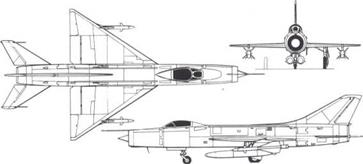Sukhoi Su-9 and Su-11
Su-9 "Fishpot B", Su-9U "Maiden" and Su-11 "Fishpot C".
Origin: The design bureau named for Pavel 0. Sukhoi. Soviet Union. Type: Single-seat all-weather interceptor (Su-9U, two-seat trainer). Engine: One Lyulka single-shaft turbojet with afterburner: (Su-9 and -9U) AL-7F rated at 1 9,8401 b (9000kg) thrust with maximum afterburner, (Su-11) AL-7F-1 rated at 22,046lb (10,000kg).
Dimensions: Span 27ft 8in (8-43m); length (-9, -9U) about 54ft (16-5m). (-11) 57ft (17-4m); height 16ft (4-9m).
Weights: (All, estimated) empty 20.000lb (9070kg): loaded (typical mission) 27,000lb (12.250kg), (maximum) 30,0001b (13,610kg). Performance: (-11, estimated) maximum speed (clean, sea level) 720mph (1160km/h, Mach 0-95), (clean, optimum height) 1,190mph (1910km/h, Mach 1-8), (two missiles and two tanks at optimum height) 790mph (1270km/h, Mach 1-2): initial climb 27,000ft (8230m)/min: service ceiling (clean) 55,700ft (17,000m): range (two missiles, two tanks) about 700 miles (11 25km).
Armament: (-9) four AA-1 "Alkali" air-to-air missiles: (r9U) same as -9, or not fitted: (-11) two AA-3 "Anab" air-to-air missiles, one radar and the other I Ft.
History: First flight (-9) before 1956: (-11) probably 1966: service delivery (-9) probably 1959, (-11) 1967.
User: Soviet Union (IA-PVO).
Development: When first seen, at the 1 956 Tushino display, one prototype delta-winged Sukhoi fighter had a small conical radome above the plain
 |
Above: Three-view of Su-11, with "Anab" missiles.
nose inlet, while a second had a conical centrebody. The latter arrangement was chosen for production as the Su-9. though development was rather protracted. At first sharing the same engine installation, rear fuselage and tail as the original Su-7, the Su-9 eventually came to have no parts exactly common. No gun was ever seen on an Su-9 by Western intelligence, the primitive missiles being the only armament. At least 2,000 were built, an additional number, probably supplemented by conversions, being tandem – seat dual trainers with a cockpit slightly different from that of the Su-7U. The Su-11 is cleaned up in every part of the airframe, has a longer and less – tapered nose with larger radar centrebody, completely different armament (still without guns) and a fuselage similar to the Su-7B with external duct fairings along the top on each side. Though much larger and more powerful than the MiG-21, these interceptors have an almost identical tailed-delta configuration. Unlike the MiG-21 they have all-weather capability (interpreted as "night and rain" rather than true all-weather), but are still limited in radius, endurance and armament. In 1976 they were together judged to equip one-quarter of the 2,500-strong interceptor force of the IA-PVO, but were being replaced by the Su-T5 and MiG-23S.
Left: A frame from a film showing both inner ‘Alkali’ missiles being fired from an Su-9 of the PVO.

Below: Large numbers of Su-11 interceptors still operate with the IA-PVO, though probably no longer in the most sensitive spots.










